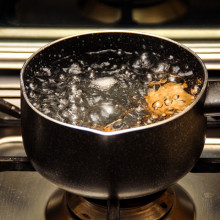Why does pasta water boil over?
This week’s question is a curious cooking query from Anthony. "When pasta or rice is added to boiling water, there is a sudden surge of the boiling water to the point that the pot boils over with bubbles. Why is this?" Phil Sansom got in touch with Phillip Broadwith, business editor of the magazine Chemistry World...
In this episode

00:00 - Why does pasta or rice water boil over?
Why does pasta or rice water boil over?
We received this im-pastable question from Anthony. To find the answer, Phil Sansom went to speak to Phillip Broadwith, business editor of Chemistry World magazine...
Phil - Ah, the classic pasta-water-rice-water surge. Enemy of carb-lovers everywhere! I got in touch with Phillip Broadwith, business editor of the Chemistry World magazine - and he said that to understand this, you first have to understand how boiling works.
Phillip - Boiling is the process of a liquid turning into a gas. It starts with a tiny bubble, formed by a small amount of water vapourising into steam – usually at some kind of imperfection on the bottom or sides of the pan.
Phil - When the bubble is big enough it detaches from the bottom or the sides and rises up, growing bigger as it rises, and bursts to the surface. Those bursting bubbles are what you see when the water rolls and boils.
Phillip - But how aggressively the water boils is determined by the temperature and the number of sites where bubbles can form. If you have water that’s hot enough to be boiling, but doesn’t have a lot of surface for bubbles to form on, it won’t boil very hard. But if you suddenly add more surface – for example by adding pasta or rice – then a lot of bubbles will form all at once, so you get that big surge. This phenomenon can be particularly spectacular if you superheat the water in a very smooth container – for example a mug in a microwave oven. It’s then possible to get the water well above 100°C without boiling, but then if you add coffee granules, you can get a huge surge of boiling, which can be quite dangerous as it'll spit scalding liquid all over you.
Phil - So boiling happens a lot quicker once there are lots of corners and edges and surfaces where the bubbles can form. Regular forum user Alan Calverd got to the same answer, but he also said, “if the added material contains starch or gluten, the bubbles can form a strong mat instead of bursting at the surface, so the next group of bubbles pushes the mat upwards and the pan boils over." So there’s a second dimension to this. Rice and pasta both contain starch and gluten, and that’s why you sometimes get that foam on the top, which adds to the boiling over problem. For rice, there’s an easy fix that I myself approve of: rinse it! And do it properly in a bowl rather than a colander, multiple times, until the water runs clear.
Phillip: This gets rid of a lot of the loose starch particles on the surface, which will also make your cooked rice less sticky. Even better cook your rice by the absorption method, which starts with the rice in a measured amount of cold water and heats it gently with a lid on until it’s absorbed all the water.
Phil - Thanks Phillip. I’m off to make dinner. Next week’s nail-biting question comes from John.
John - I want to know, if enough people in the world donated their finger and toenail clippings, could enough keratin be produced to satisfy the demand, and thus stop poaching of wild animals in Africa?
Related Content
- Previous Code Making and Breaking
- Next The Dog Show










Comments
Add a comment